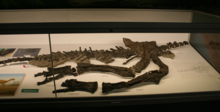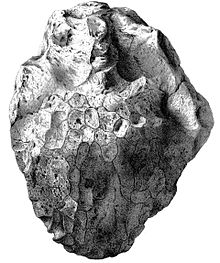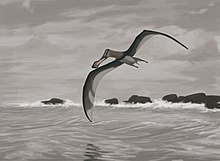Wessex Formation
| Wessex Formation | |
|---|---|
| Stratigraphic range: | |
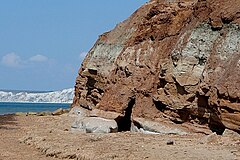 Exposure of the Wessex Formation west ofChilton Chine | |
| Type | Geological formation |
| Unit of | Wealden Group |
| Sub-units | Coarse Quartz Grit (in Dorset) |
| Underlies | Vectis Formation |
| Overlies | Durlston Formation |
| Thickness | up to 1000 m near Swanage |
| Lithology | |
| Primary | mudstone |
| Other | sandstone,ironstone&conglomerate |
| Location | |
| Region | Southern England |
| Country | |
| Extent | Dorset,Isle of Wight,offshoreWessex Basin |
| Type section | |
| Named for | Wessex |
| Named by | Daley and Stewart |
| Location | Bacon Hole,Mupe Bay |
| Year defined | 1979 |
 Exposure of the Wessex and Vectis Formations on the South Coast of the Isle of Wight, shown in turquoise. | |

TheWessex Formationis afossil-richEnglishgeological formationthat dates from theBerriasiantoBarremianstagesof theEarly Cretaceous.It forms part of theWealden Groupand underlies the youngerVectis Formationand overlies theDurlston Formation.[1]The dominantlithologyof this unit ismudstonewith some interbeddedsandstones.It is part of the strata of theWessex Basin,exposed in both theIsle of Purbeckand theIsle of Wight.While the Purbeck sections are largely barren of vertebrate remains, the Isle of Wight sections are well known for producing the richest and most diverse fauna in Early Cretaceous Europe.
Nomenclatural history
[edit]Historically, the Wessex Formation has been called alternately the "Variegated Marls and Sandstones",a name used byW. J. Arkellin his 1947 map of the Isle of Purbeck[2]as well as the "Wealden Marls"[3]It was given its current formal name by Daley and Stewart in 1979.[4]
Stratigraphy and lithology
[edit]Introduction
[edit]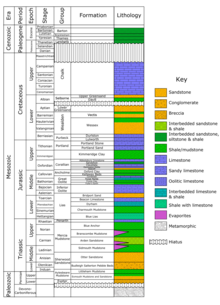
The Wessex Formation forms part of theWealden Groupwithin theWessex Basin,an area ofsubsidencesincePermo-Triassictimes. The basin is located along southern half of the Isle of Wight and Purbeck, extending offshore into theEnglish Channel.The Wealden Group is also exposed significantly in theWeald Basin,which has a separate stratigraphic succession. The Wealden Group is not widely present elsewhere in Britain, as these areas weretectonic highswhere little to nosediment depositionwas taking place. The formation has limited exposure as it has been deeply buried beneath the subsequentLower Greensand.SelbourneandChalk Groups,as well as being very vulnerable to erosion. It has been exposed at the surface due to the creation ofanticlinalstructures as a distant effect of the formation of thePyreneesas part of theAlpine Orogenyduring thePaleogene.[5]
Cornubian Massif
[edit]The major source rocks for the sediments were from theCornubian Massifto the west, an upland region roughly equivalent to the extent ofCornwallandDevon,with occasional largedropstonestransported in tree roots being found in Wealden sediments over 100 kilometres from where they originated.[6]
The Wessex Formation in the Isle of Purbeck
[edit]The exposure in of the Wessex Formation in theIsle of Purbeckis largely confined to a thin belt on the south side of thePurbeck Ridgeand is best exposed atSwanage,[7]Lulworth Cove[8]andWorbarrow Bay.[9]One notable persistent horizon within the Purbeck sections of the formation is the "Coarse Quartz Grit", an up to 6 metre thick sequence ofconglomeraticironstone,with many beds including numerous centimetre sizedsubangular to roundedpebbles predominantly ofveinderivedquartz,hence the name. This horizon is present throughout the Purbeck outcrops of the Wessex Formation.[9]The transition to theVectis Formationat Swanage is obscured by a landslip.[10]
The Wessex Formation of the Isle of Wight
[edit]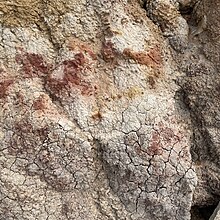
The Isle of Wight succession has two primary exposures, The major one being the several kilometre long section along the South West coastline aroundBrighstone Bay,and another smaller exposure on the South East coast nearYaverland.While the formation taken as a whole dates from theBerriasianto the Barremian, only the uppermost part of the formation is exposed on the Isle of Wight. With less than 200 metres of exposed composite stratigraphic thickness, and which dates fromHauteriviantoBarremian.[11]A radiometric date has been obtained from the lower part of the succession, estimated to be 127.3 ± 2.7 million years ago.[12]This makes the formation coeval with upper portion of theWeald Clayin the Weald Basin. The primary lithology of the exposed portion of the formation on the Isle of Wight consists of featureless purple-redoverbankmudstone,interbeddedwith sandstones. Theenvironment of depositionwas afloodplainwithin a narrow, east–west oriented valley.[13]The climate at the time of deposition is considered to besemi-arid,based on the presence ofpedogeniccalcretenoduleswithin the mudstones.[14]The "Pine Raft" horizon found near the base of the exposed portion of the formation includes calcitized conifer trunks up to metre in diameter and 2–3 metres long.[15]

Plant debris beds
[edit]
A notable feature of the formation are the so-called "plant debris beds". These consist of a basalmatrix supportedconglomerate,grading upwardsinto grey mudstone withligniticplant debris, including large trunk fragments of the extinct coniferPseudofrenelopsispresent in the upper portion. These were formed bysheet flood depositsinduced by storms that filled pre-existing topographic lows likeoxbow lakesand abandonedchannelsin the floodplain depositional environment.[16]The debris beds do not form a continuous horizon throughout the formation, but are laterally extensive over tens of metres. Many of the wood fragments in the debris beds are cemented together with largenodulesofpyrite,suggesting depositional conditions wereanoxic.[17]Most fossils within the formation are associated with the debris beds. Vertebrate fossils are mostly disarticulated individual bones and teeth, suggesting a longsubaerialexposure prior to burial, though the bones lackabrasion,suggesting that they had not been significantly transported. Partial skeletons also sometimes occur, but are uncommon. Autochthonoussideritenodules are also present, which encase some of the fossils.[16]Plant debris beds also exist within the Swanage section, and one of these horizons has yielded microvertebrate remains.[10]
"Hypsilophodonbed "
[edit]
While most fossils are associated with the plant debris beds, a notable exception is the "Hypsilophodonbed "present near the top of the formation, an up to 1 metre thick bed of silty red-green mudstone, with two separate horizons that have produced almost exclusively over a hundred complete and articulated skeletons of the dinosaurHypsilophodon,sometimes even with preserved tail tendons. The bed is laterally extensive, being persistent for over a kilometre. It has been recently suggested that the accumulation of skeletons were amass mortality eventcaused by acrevasse splay.Just above the "Hypsilophodonbed "the red mudstones of the Wessex Formation change to the transitional light coloured sandstone" White rock "and overlying laminated grey mudstones of theVectis Formation,caused by the changing of environmental conditions from that of a floodplain to coastallagoonconditions.[18]
Palaeoenvironment
[edit]The palaeoenvironment of the Wessex Formation is considered to have been semi-arid, and has variously been compared tochaparral[13]ormacchia[10]Mediterraneanshrubland.The dominant trees were conifers of the extinct familyCheirolepidiaceaebelonging to the generaPseudofrenelopsisandWatsoniocladus,both of which have reducedxerophyticleaves adapted to arid conditions.[10]Tree cover is thought to have been thin, and concentrated near waterways.[19]The ground cover is thought to have consisted of xerophyticferns.[10]Wildfireswere common occurrences, as evidenced by preserved charred vegetation.[16]
Fauna
[edit]The Wessex Formation likely spans several million years of deposition, and not all taxa are likely to have been contemporaneous.[20]
Invertebrates
[edit]Invertebratesare commonly preserved in the Wessex Formation. Freshwaterbivalvescan be found includingunionidssuch asMargaritifera,Nippononaia,andUnio.These bivalves help reconstruct what thefreshwaterpaleoenvironmentmay have been like during the formation's deposition. Specimens ofViviparus,a genus offreshwater snail,have also been found. While compression fossils of insects are found in the overlying Vectis Formation, all insect fossils in the Wessex Formation are found as inclusions in amber. Amber can be found present as a rare component in plant debris beds in the Wessex formation both on the Isle of Wight and the Isle of Purbeck, however, the only significant concentration and where all of the inclusions have been found is a lag channel in the L6 plant debris horizon just south-east ofChilton Chine.Only four species from the amber have been formally described,Cretamygale chaseiamygalomorphspider,Dungeyella gavini[21]Libanodiamesa simpsoni,bothchironomidmidges, as well asEmbolemopsis maryannae,aembolemidparasitic wasp. However a table of undescribed taxa has been given,[21]and several images of some of the undescribed taxa have been released from various sources, including multiple chironomids, and athereviddipteran.[22]
Color key
|
Notes Uncertain or tentative taxa are insmall text; |
Arthropods
[edit]| Arthropodsof the Wessex Formation | ||||||
|---|---|---|---|---|---|---|
| Genus | Species | Location | Stratigraphic Position | Abundance | Note | Images |
| Cypridea[23] | C. wicheri, C. brevirostrata | Dungy Head | Base of the formation | Anostracodbelonging toCypridoidea | ||
|
C. chasei[24] |
Chilton Chine | L6 plant debris bed | Single specimen | Mygalomorph spider, has been described from a specimen found in amber. | See article | |
| Dungeyella | D. gavini[25] | Chilton Chine | L6 plant debris bed | Multiple specimens | A tinybuchonomyiinechironomidmidge | See article |
| Embolemopsis | E. maryannae[26] | Chilton Chine | L6 plant debris bed | Single specimen | Embolemidparasitic wasp, genus also known from theZaza Formation.Specimen previously described as adryinidin a 2015 conference abstract.[22] | 
|
| Protopangu | P. valdensis[27] | Chilton Chine | L6 plant debris bed | Single specimen | Apanguidparasiticstinging wasp | |
| Libanodiamesa | L. simpsoni[28] | Chilton Chine | L6 plant debris bed | Single specimen | Prodiamesinaechironomid, genus also known from theLebanese amber | |
| Chironomidae |
Indeterminate |
Chilton Chine | L6 plant debris bed | 44% of all arthropod inclusions | Uncertain how many taxa represented, likely at least two. At least one is a tanypodian with a wingspan twice that ofDungeyella. | |
| Therevidae | Indeterminate | Chilton Chine | L6 plant debris bed | At least one specimen | At least one specimen figured | 
|
| Diptera | Indeterminate | Chilton Chine | L6 plant debris bed | Multiple specimens | Uncertain how many taxa represented | |
| Hymenoptera |
Indeterminate |
Chilton Chine | L6 plant debris bed | Multiple specimens | Uncertain how many taxa represented | |
| Blattodea |
Indeterminate |
Chilton Chine | L6 plant debris bed | Single specimen | ||
| Coleoptera |
Indeterminate |
Chilton Chine | L6 plant debris bed | Single specimen | ||
| Curculionoidea? |
Indeterminate |
Represented by a boring in a gymnospermous seed.[29] |
||||
Vertebrates
[edit]Dinosaurs
[edit]Ornithischians
[edit]Ankylosaurs
[edit]| Ankylosaursreported from the Wessex Formation | ||||||
|---|---|---|---|---|---|---|
| Genus | Species | Synonyms | Stratigraphic Position | Material | Notes | Images |
| Polacanthus | P. foxii | Dorsal vertebrae, dorsosacral vertebrae, sacral vertebrae, caudosacral vertebra, caudal vertebrae, dorsal ribs, ilia, pubes, ischia, femora, tibia, distal end of fibula, astragalus, metatarsals, ungual phalanx, sacral shield and osteoderms. | Anankylosaur | |||
| Vectipelta | V. barretti | L5 | Partial skeleton | Anankylosaur.Referred to as the "Spearpoint ankylosaur" prior to its original description. Only distantly related toPolacanthus. | ||
Neornithischians
[edit]| Neornithischiansreported from the Wessex Formation | ||||||
|---|---|---|---|---|---|---|
| Genus | Species | Synonyms | Stratigraphic Position | Material | Notes | Images |
| Brighstoneus | B. simmondsi | L9 | Partial skeleton[30] | Ahadrosauriformiguanodontian | 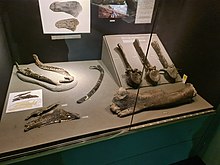 | |
| Comptonatus | C. chasei | Compton Bay | Partial skeleton[20] | Aniguanodontiandinosaur |  | |
|
H. foxii |
Hypsilophodonbed | Many partial skeletons | Ahypsolophodontid | 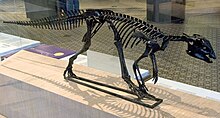 | ||
|
Indeterminate |
Yaverland bed 38 | Teeth | Resemble the cheek teeth of the heterodontosauridTianyulong.[31] | |||
|
I. bernissartensis |
Ahadrosauroidiguanodontian.Specimens classified asIguanodon seelyiare referable to this species |
 | ||||
|
M. atherfieldensis |
Dollodon bampingi,Proplanicoxa?[32] |
Ahadrosauroidiguanodontian | 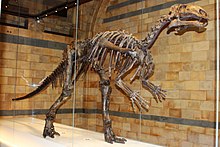 | |||
|
V. canaliculatus |
Recovered from various parts of the formation | Multiple partial skeletons | Adryosaurid | |||
| Vectidromeus[33] | V. insularis | Lower part of the formation | Associated elements of the dorsal vertebrae, pelvis, hindlimbs, and tail, from a juvenile specimen | Ahypsilophodontid |  | |
Saurischians
[edit]Sauropods
[edit]| Sauropodsreported from the Wessex Formation | ||||||
|---|---|---|---|---|---|---|
| Genus | Species | Location | Stratigraphic Position | Material | Notes | Images |
|
C. gigas |
"Several cervical vertebrae."[34] |
|||||
|
E. foxi |
"Dorsal vertebra."[34] |
Perhaps asomphospondylan?[35] | ||||
|
I. valdensis |
"Several caudal vertebrae."[34] |
|||||
|
O. armatus |
"Tooth."[36] |
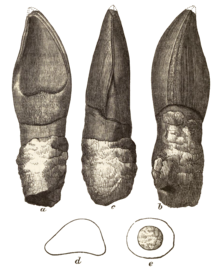 | ||||
|
O. eucamerotus |
"Ischia and pubis.",[34]regarded as an "undiagnostic titanosauriform of uncertain affinities." |
|||||
|
O. hulkei |
One dorsal vertebra.[37] |
|||||
| UndescribedSauropod(Barnes High sauropod) | Indeterminate | "Partial postcranial skeleton, including presacral vertebrae, anterior caudal vertebrae, girdle and limb elements"[38] | Currently in private collection and unavailable to researchers. Known informally as "the Barnes High sauropod". Possibly the same asEucamerotus[38] | |||
| "Angloposeidon"(informal) | Indeterminate | L1 | One cervical vertebra and possible associated centrum[39] | Represents a large animal 20 metres or greater in length. Known informally as "Angloposeidon".Perhaps asomphospondylan? |  | |
|
Indeterminate |
Scapula found approximately around L11 |
Scapula, radius and ulna, several cervical sacral and caudal vertebrae and isolated teeth from multiple individuals[40] |
Taxon has close affinities withDemandasaurusandNigersaurus[41] |
|||
|
Indeterminate |
Two isolated large middle caudal vertebra, one isolated large cervical vertebra, BMNH R5333, two articulated caudal vertebrae with an articulated fragment of a third |
|||||
Theropods
[edit]| Theropodsreported from the Wessex Formation | ||||||
|---|---|---|---|---|---|---|
| Genus | Species | Location | Stratigraphic Position | Material | Notes | Images |
|
Indeterminate |
Isolated teeth |
Possibly anEnantiornitheand aHesperornithidpresent | ||||
|
A. pusillus |
"Sacrum and pubis."[42] |
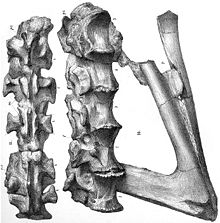 | ||||
|
C. foxi |
"Vertebrae."[43] |
A compsognathid |
 | |||
|
C. oweni |
"Vertebrae."[43] |
A possibleoviraptorosaur |
||||
|
C. inferodios |
Partial skull material[44] |
Aspinosaurid,formerly considered remains ofBaryonyx. |
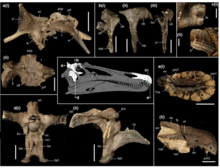 | |||
|
E. lengi |
"Partial skull and skeleton."[45] |
Atyrannosauroid |  | |||
|
N. salerii |
Cranial and postcranial remains of at least four individuals. |
|||||
|
O. cluniculus |
A species ofdromaeosaurid,once misidentified as a pterosaur |
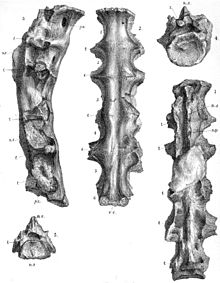 | ||||
|
Indeterminate |
Teeth |
Dubious, uncertain referral on the genus level |
||||
|
R. milnerae |
Partial skull and referred caudal material[44] |
Aspinosaurid,formerly considered remains ofBaryonyx. |
 | |||
| Tetanurae | Indeterminate | Chilton Chine | Partial pubis and femur[46] | Distinct fromNeovenatorandBaryonyx.Currently in private collection. | ||
|
T. daviesi |
"Cervical vertebrae."[47] |
A theropod of uncertain classification, possibly anornithomimosaur(this assignment has been questioned by both Mortimer and Naish).[48][49] |
 | |||
| Undescribedcoelurosaur | Indeterminate | Partial associated skeleton | Apparently small. In private collection and undescribed. Referred to as "That Which Cannot Be Named" byDarren Naish[48]Has been suggested to be a tyrannosauroid.[50][31] | |||
| Coelurosauria | Indeterminate (or possiblyC. oweni) | Tibia | Previously referred toHypsilophodon,Aristosuchus,Calamosaurus,Ornithomimosauriaindet. andCoelurosauriaindet. | 
| ||
|
Indeterminate |
Isolated teeth |
May belong to aproceratosaurid,[51]or alternatively they may belong toVectiraptor. |
||||
|
V. greeni |
Dorsal vertebrae and sacral vertebrae |
A large bodiedEudromaeosaur |
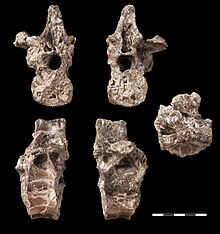 | |||
|
Y. bitholus |
Yaverland | Known from a "partial skull roof comprising both frontals and parts of the right postorbital and left orbitosphenoid". A second specimen is known but has not been formally published. |
Amaniraptoranof uncertain classification, originally identified as an ornithischian. |
 | ||
Fish
[edit]Cartilaginous fishes
[edit]| Cartilaginous fishesof the Wessex Formation[52] | ||||||
|---|---|---|---|---|---|---|
| Genus | Species | Location | Stratigraphic Position | Abundance | Note | Images |
|
H. basanus |
Hybodontidhybodontshark | |||||
| Hybodus |
Indeterminate 1 |
Yaverland bed 38, L9 |
||||
|
Indeterminate 2 |
Yaverland bed 38, L9 |
|||||
|
Indeterminate 3 |
Yaverland bed 38, L9 |
|||||
|
L. breve |
Yaverland bed 38 |
Lonchidiidhybodont shark | ||||
|
L. striatum |
Yaverland bed 38, L9 |
51.43% of total chondrichthyan taxa in L9 |
||||
|
Indeterminate 1 |
Yaverland bed 38, L9 |
|||||
|
Indeterminate 2 |
Yaverland bed 38, L9 |
35.86% of total chondrichthyan taxa in Yaverland bed 38 |
||||
|
Indeterminate 3 |
Yaverland bed 38, L9 |
|||||
|
H. problematica |
||||||
|
Indeterminate |
Catshark | |||||
|
P. heterodon |
Lonchidiid hybodont shark | |||||
|
Indeterminate |
Selachimorph shark | |||||
|
V. ornatus |
Lonchidiid hybodont shark | |||||
Ray-finned fish
[edit]| Ray-finned fishesof the Wessex Formation[52] | ||||||
|---|---|---|---|---|---|---|
| Genus | Species | Location | Stratigraphic Position | Abundance | Notes | Images |
|
Indeterminate |
Aspidorhynchiformes | Known from isolated teeth |  | |||
|
Indeterminate |
Amiiformfish |  | ||||
|
Indeterminate |
Pycnodontidfish | |||||
|
Indeterminate |
Coccolepididfish | |||||
|
Indeterminate |
||||||
|
Indeterminate |
||||||
|
Indeterminate |
||||||
|
Indeterminate |
||||||
|
Indeterminate |
Lepidotidfish |  | ||||
Mammals
[edit]| Mammalsof the Wessex Formation | ||||||
|---|---|---|---|---|---|---|
| Genus | Species | Location | Stratigraphic Position | Material | Notes | Images |
|
E. clemensi[54] |
Multiple debris beds | L9, Yaverland bed 38 and CL3 |
Teeth |
Eobaataridmultituberculate | ||
| ?Gobiconodon | Indeterminate | Yaverland | Yaverland bed 38 | A lower right premolariform[55] | Gobiconodontid | |
|
?L. valdensis[54] |
Teeth |
Eobaatarid multituberculate | ||||
|
Y. gassoni |
Multiple debris beds | Mandible from Yaverland bed 38, isolated teeth from L2, L9 and L14 |
Mandible Fragment and isolated teeth |
Spalacotheriid | 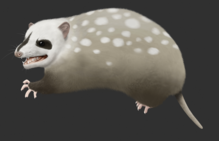
| |
|
Indeterminate |
Multiple debris beds | Yaverland bed 38 and L9 | A lower right molar (NHMUK.M45558) C, an upper left molar (NHMUK.M45564)., a tentatively referred lower left or upper right premolar (NHMUK.M45484)[55] | |||
| Eutriconodonta | Indeterminate | Yaverland | Yaverland bed 38 | Lower left molariform | ||
|
Indeterminate |
Premolars |
Eutheria? |
||||
Lissamphibians
[edit]| Amphibiansof the Wessex Formation | ||||||
|---|---|---|---|---|---|---|
| Genus | Species | Location | Stratigraphic Position | Abundance | Notes | Images |
| Wesserpeton[58] | W.evansae | L2 and Yaverland 38 | Albanerpetontidamphibian | |||
|
Indeterminate |
Multiple | 1: Yaverland 38 2: L2 and Yaverland 38 3: L2 and Yaverland 38 4: Yaverland 38 5: Yaverland 38 | At least 5 distinct taxa distinguished by characters in theirilium | |||
| Urodela | Indeterminate | Multiple | 1: L2, L14 and Yaverland 33 and 38 2: L9 and Yaverland 38 3: unnamed bed in Compton bay and Yaverland 38 | At least 3 distinct taxa distinguished by theiratlas vertebrae | ||
Reptiles
[edit]Squamates
[edit]| Squamatesof the Wessex Formation | ||||||
|---|---|---|---|---|---|---|
| Genus | Species | Location | Stratigraphic Position | Abundance | Notes | Images |
| Meyasaurus[58] | Indeterminate | Yaverland | Yaverland bed 38 | Teeth and a partial lower jaw | Genus also known from Spain | |
| Anguimorpha[57] |
indeterminate |
Multiple plant debris beds | 1st taxon L14 and L2, 2nd L2 and Yaverland bed 38, 3rd Yaverland bed 38 | At least 3 distinct taxa represented by isolated teeth, maxilla and lower jaw fragments, alongside a possible fourth taxon.[31] | ||
| Scincomorpha[57] |
indeterminate |
Multiple plant debris beds | 1: L14 and Yaverland 38 2: Yaverland 38, 3: L2 and Yaverland 38 4,5: Yaverland bed 38 6:L2, L14 and Yaverland 38 7,8,9: Yaverland 38 10: L2, L14 and Yaverland 38 | At least 10 distinct taxa represented by isolated teeth, maxilla and lower jaw fragments, some of which areparamacellodidsbased on the common occurrence of osteoderms typical of this clade.[31] | ||
Neosuchians
[edit]| Neosuchiansof the Wessex Formation | ||||||
|---|---|---|---|---|---|---|
| Genus | Species | Location | Stratigraphic Position | Abundance | Notes | Images |
|
A. hooleyi |
Disputed, either uppermost Wessex or lowermost Vectis | |||||
| A. epikrator[60] | Hanover Point | Mostly complete skull and partial dentaries and associated postcranial material | 
| |||
| Bernissartia | Indeterminate | 40 Isolated teeth | ||||
|
H. willetti |
||||||
|
K. aprosdokiti[61] |
||||||
|
Indeterminate |
||||||
| Vectisuchus | V. leptognathus | Barnes High | Just below base of Vectis formation | "Partial semi-articulated skeleton" | ||
Plesiosaurs
[edit]| Plesiosaursof the Wessex Formation | ||||||
|---|---|---|---|---|---|---|
| Genus | Species | Location | Stratigraphic Position | Abundance | Notes | Images |
|
Indeterminate |
Compton Bay |
Vertebra |
||||
|
Indeterminate |
Tie pits, atherfield |
Propodial |
Leptocleididae? |
|||
Turtles
[edit]| Turtlesof the Wessex Formation | ||||||
|---|---|---|---|---|---|---|
| Genus | Species | Location | Stratigraphic Position | Material | Notes | Images |
|
H. nopcsai |
Shell and skull material | Helochelydrid | ||||
|
B. brodiei |
Shell fragments | Xinjiangchelyid,previously known by the synonymsPlesiochelys brodieiLydekker, 1889;Plesiochelys valdensisLydekker, 1889 andPlesiochelys vectensisHooley, 1900[63] | ||||
| Eodortoka[12] | E.cf.morellana | Partial shell with associated vertebrae and limb bones | Adortokidpanpleurodiranturtle. | |||
Pterosaurs
[edit]| Pterosaursof the Wessex Formation | ||||||
|---|---|---|---|---|---|---|
| Genus | Species | Location | Stratigraphic Position | Material | Notes | Images |
|
C. trimicrodon |
Skull and rostrum fragments |
Anornithocheirid |  | |||
|
Indeterminate |
Tooth, potentially a gnathosaurine |
|||||
|
I. latidens |
Partial skeleton and skull, and referred mandible fragment |
Anistiodactylid |  | |||
|
Indeterminate |
Found throughout the sub basin |
Teeth |
Two other species, distinct fromI.latidens |
|||
|
Indeterminate |
Humerus |
|||||
| Ornithocheiridae | Indeterminate | "partial distal left metacarpal IV"[64] | Estimated wingspan of 5.6 metres | |||
|
U. rodriguesae |
Rostrum fragment |
Anornithocheirid,distinct fromColoborhynchus | ||||
|
W. declivirotris |
Rostrum fragment |
|||||
Flora
[edit]Spermatophytes
[edit]| Spermatophytesreported from the Wessex Formation | ||||||
|---|---|---|---|---|---|---|
| Family | Genus | Species | Stratigraphic Position | Material | Notes | Images |
| Araucariaceae | Agathoxylon? | Indeterminate | Wood | Reported as "Dadoxylon"
Considered a dubious referral[citation needed] |
||
| Araucariaceae | Brachyphyllum | B. obesum | Leaves | |||
| Cheirolepidiaceae | Pseudofrenelopsis | P. parceramosa | Leaves and abundant, occasional segments of trunk | |||
| Cheirolepidiaceae | Watsoniocladus | W. valdensis | Leaves | |||
| Cupressaceae | Sphenolepis | Leaves | "taxodiaceous" | |||
| Pinaceae | Pityites | P. solmsii | ||||
Pteridophytes
[edit]| Pteridophytesreported from the Wessex Formation | ||||||
|---|---|---|---|---|---|---|
| Genus | Species | Location | Stratigraphic Position | Material | Notes | Images |
|
Indeterminate |
||||||
|
Indeterminate |
May actually originate from the underlyingPurbeck Group.[10] |  | ||||
|
W. reticulata |
Multiple specimens |
|||||
See also
[edit]- List of fossil sites
- List of stratigraphic units with dinosaur body fossils
- Dinosaurs of the Isle of Wight
References
[edit]- ^"Wessex Formation".The BGS Lexicon of Named Rock Units.British Geological Survey.
- ^Arkell, W. J. (1947). "The Geology of the country around Weymouth, Swanage, Corfe and Lulworth".Memoir of the Geological Survey of Great Britain.
- ^Osbourne White, H. J. (1921). "A short account of the geology of the Isle of Wight".Memoir of the Geological Survey of Great Britain.
- ^Daley, B.; Stewart, D. J. (1979). "Weekend field meeting: The Wealden Group in the Isle of Wight".Proceedings of the Geologists' Association.90:51–54.doi:10.1016/S0016-7878(79)80031-0.
- ^Parrish, Randall R.; Parrish, Claire M.; Lasalle, Stephanie (May 2018)."Vein calcite dating reveals Pyrenean orogen as cause of Paleogene deformation in southern England".Journal of the Geological Society.175(3): 425–442.Bibcode:2018JGSoc.175..425P.doi:10.1144/jgs2017-107.ISSN0016-7649.S2CID134690307.
- ^Sweetman, Steven C.; Goodyear, Matthew (August 2020)."A remarkable dropstone from the Wessex Formation (Lower Cretaceous, Barremian) of the Isle of Wight, southern England".Proceedings of the Geologists' Association.131(3–4): 301–308.doi:10.1016/j.pgeola.2019.06.005.S2CID198408317.
- ^West, Ian."Swanage Bay and Ballard Cliff".Geology of the Wessex Coast of Southern England.
- ^West, Ian."Lulworth Cove, Dorset".Geology of the Wessex Coast of Southern England.
- ^abWest, Ian."Worbarrow Bay".Geology of the Wessex Coast of England.
- ^abcdefPenn, Simon J.; Sweetman, Steven C.; Martill, David M.; Coram, Robert A. (November 2020)."The Wessex Formation (Wealden Group, Lower Cretaceous) of Swanage Bay, southern England".Proceedings of the Geologists' Association.131(6): 679–698.doi:10.1016/j.pgeola.2020.07.005.S2CID228820795.
- ^Hughes, N.F.; McDougall, A.B. (January 1990). "New Wealden correlation for the Wessex Basin".Proceedings of the Geologists' Association.101(1): 85–90.doi:10.1016/S0016-7878(08)80208-8.
- ^abJacobs, M. L.; Pérez-García, A.; Martín-Jiménez, M.; Mottram, C. M.; Martill, D. M.; Gale, A. S.; Mattsson, O.; Wood, C. (2023)."A well preserved pan-pleurodiran (Dortokidae) turtle from the English Lower Cretaceous and the first radiometric date for the Wessex Formation (Hauterivian-Barremian) of the Isle of Wight, United Kingdom".Cretaceous Research.150.105590.doi:10.1016/j.cretres.2023.105590.
- ^abInsole, Allan N.; Hutt, Stephen (September 1994). "The palaeoecology of the dinosaurs of the Wessex Formation (Wealden Group, Early Cretaceous), Isle of Wight, Southern England".Zoological Journal of the Linnean Society.112(1–2): 197–215.doi:10.1111/j.1096-3642.1994.tb00318.x.
- ^Robinson, Stuart A.; Andrews, Julian E.; Hesselbo, Stephen P.; Radley, Jonathan D.; Dennis, Paul F.; Harding, Ian C.; Allen, Perce (March 2002). "Atmospheric pCO 2 and depositional environment from stable-isotope geochemistry of calcrete nodules (Barremian, Lower Cretaceous, Wealden Beds, England)".Journal of the Geological Society.159(2): 215–224.Bibcode:2002JGSoc.159..215R.doi:10.1144/0016-764901-015.ISSN0016-7649.S2CID55188160.
- ^Radley, Jonathan D.; Allen, Percival (April 2012). "The Wealden (non-marine Lower Cretaceous) of the Wessex Sub-basin, southern England".Proceedings of the Geologists' Association.123(2): 319–373.doi:10.1016/j.pgeola.2012.01.002.
- ^abcSweetman, Steven C.; Insole, Allan N. (June 2010). "The plant debris beds of the Early Cretaceous (Barremian) Wessex Formation of the Isle of Wight, southern England: their genesis and palaeontological significance".Palaeogeography, Palaeoclimatology, Palaeoecology.292(3–4): 409–424.Bibcode:2010PPP...292..409S.doi:10.1016/j.palaeo.2010.03.055.
- ^Radley, Jon D. (January 1994). "Stratigraphy, palaeontology and palaeoenvironment of the Wessex Formation (Wealden Group, Lower Cretaceous) at Yaverland, Isle of Wight, southern England".Proceedings of the Geologists' Association.105(3): 199–208.doi:10.1016/S0016-7878(08)80119-8.
- ^Coram, Robert A.; Radley, Jonathan D.; Martill, David M. (March 2017). "A Cretaceous calamity? The Hypsilophodon Bed of the Isle of Wight, southern England".Geology Today.33(2): 66–70.doi:10.1111/gto.12182.S2CID133499912.
- ^Radley, Jonathan D.; Allen, Percival (April 2012)."The southern English Wealden (non-marine Lower Cretaceous): overview of palaeoenvironments and palaeoecology".Proceedings of the Geologists' Association.123(2): 382–385.doi:10.1016/j.pgeola.2011.12.005.ISSN0016-7878.
- ^abLockwood, Jeremy A. F.; Martill, David M.; Maidment, Susannah C. R. (2024-12-31)."Comptonatus chasei, a new iguanodontian dinosaur from the Lower Cretaceous Wessex Formation of the Isle of Wight, southern England".Journal of Systematic Palaeontology.22(1).doi:10.1080/14772019.2024.2346573.ISSN1477-2019.
- ^abJarzembowski, E.; Azar, D.; Nel, A. (2009-04-24). "A new chironomid (Insecta: Diptera) from Wealden amber (Lower Cretaceous) of the Isle of Wight (UK)".Geologica Acta.6(3): 285–291.doi:10.1344/105.000000257.ISSN1696-5728.
- ^abJarzembowski, E. A. (27 March 2015)."Fossil resins from England (Conference abstract)"(PDF).Amberif 2015: SUCCINITE AND SELECTED FOSSIL RESINS OF EUROPE: LOCALITIES, PROPERTIES, ARCHAEOLOGY:18–20.
- ^Penn, Simon J.; Sweetman, Steven C. (March 2023)."Microvertebrate-rich gutter casts from the basal Wessex Formation (Wealden Group, Lower Cretaceous) of Dungy Head, Dorset: Insights into the palaeoecology and palaeoenvironment of a non-marine wetland".Cretaceous Research.143:105397.doi:10.1016/j.cretres.2022.105397.S2CID253401972.
- ^"FIRST BRITISH MESOZOIC SPIDER, FROM CRETACEOUS AMBER OF THE ISLE OF WIGHT, SOUTHERN ENGLAND".26 September 2001.
- ^"Fossil specimen: MIWG IWCMS.1994.99 – Holotype".GB3D Type Fossils.
- ^Perkovsky, Evgeny E.; Olmi, Massimo; Müller, Patrick; Guglielmino, Adalgisa; Jarzembowski, Edmund A.; Capradossi, Leonardo; Rasnitsyn, Alexandr P. (2020-11-21)."A review of the fossil Embolemidae (Hymenoptera: Chrysidoidea), with description of seven new species and history of the family".Cretaceous Research.121:104708.doi:10.1016/j.cretres.2020.104708.ISSN0195-6671.S2CID229502829.
- ^Zhuang, Yuhui; Li, Jiahao; Jarzembowski, Edmund A.; Wang, Bo; Zhang, Qingqing (2024-02-12)."A new genus of Panguoidea in Lower Cretaceous Wealden amber".Historical Biology:1–4.doi:10.1080/08912963.2024.2309637.ISSN0891-2963.
- ^Baranov, Viktor; Giłka, Wojciech; Zakrzewska, Marta; Jarzembowski, Edmund (March 2019). "New non-biting midges (Diptera: Chironomidae) from Lower Cretaceous Wealden amber of the Isle of Wight (UK)".Cretaceous Research.95:138–145.doi:10.1016/j.cretres.2018.11.012.S2CID131766366.
- ^Legalov, A & A. Jarzembowski, Edmund. (2017). First record of a weevil (Coleoptera: Nemonychidae) from the Lower Cretaceous (Wealden) of southern England. Cretaceous Research. 82. 10.1016/j.cretres.2017.10.006.
- ^Lockwood, Jeremy A. F.; Martill, David M.; Maidment, Susannah C. R. (2021-11-10)."A new hadrosauriform dinosaur from the Wessex Formation, Wealden Group (Early Cretaceous), of the Isle of Wight, southern England".Journal of Systematic Palaeontology.19(12): 847–888.doi:10.1080/14772019.2021.1978005.ISSN1477-2019.S2CID244067410.
- ^abcdSweetman, Steven C. (March 2016)."A comparison of Barremian–early Aptian vertebrate assemblages from the Jehol Group, north-east China and the Wealden Group, southern Britain: the value of microvertebrate studies in adverse preservational settings".Palaeobiodiversity and Palaeoenvironments.96(1): 149–167.doi:10.1007/s12549-015-0217-9.ISSN1867-1594.S2CID129956539.
- ^McDonald, Andrew T. (2011). "The status of Dollodon and other basal iguanodonts (Dinosauria: Ornithischia) from the upper Wealden beds (Lower Cretaceous) of Europe". Cretaceous Research. 33: 1–6. doi:10.1016/j.cretres.2011.03.002.
- ^Longrich, Nicholas R.; Martill, David M.; Munt, Martin; Green, Mick; Penn, Mark; Smith, Shaun (2023-09-13)."Vectidromeus insularis, a new hypsilophodontid dinosaur from the Lower Cretaceous Wessex Formation of the Isle of Wight, England".Cretaceous Research.154:105707.doi:10.1016/j.cretres.2023.105707.ISSN0195-6671.
- ^abcd"Table 13.1," in Weishampel, et al. (2004). Page 271.
- ^Campbell, Amy, Paul Upchurch, and Phillip D. Mannion. The anatomy and relationships of Eucamerotus foxi (Dinosauria, Sauropoda) from the Early Cretaceous of England. No. e3247v1. PeerJ Preprints, 2017.
- ^"Table 13.1," in Weishampel, et al. (2004). Page 261.
- ^"Table 13.1," in Weishampel, et al. (2004). Page 266.
- ^ab"Sauropod dinosaurs".Field Guide to English Wealden Fossils.Palaeontological Association. 2011.
- ^Naish, Darren; Martill, David M.; Cooper, David; Stevens, Kent A. (December 2004). "Europe's largest dinosaur? A giant brachiosaurid cervical vertebra from the Wessex Formation (Early Cretaceous) of southern England".Cretaceous Research.25(6): 787–795.doi:10.1016/j.cretres.2004.07.002.
- ^Larkin, N. R., Green, M., Lomax, D. R., Cocks, A. and Schouten, R. 2019.Making a complete record of early Cretaceous (late Barremian early Aptian) rebbachisaur Sauropoda, Rebbachisauridae) remains found on the Isle of Wight, UK, including unpublished material.The Annual Symposium of Vertebrate Palaeontology and Comparative Anatomy. Vol 67.
- ^Mannion, Philip D.; Upchurch, Paul; Hutt, Stephen (December 2011)."New rebbachisaurid (Dinosauria: Sauropoda) material from the Wessex Formation (Barremian, Early Cretaceous), Isle of Wight, United Kingdom".Cretaceous Research.32(6): 774–780.doi:10.1016/j.cretres.2011.05.005.
- ^"Table 4.1," in Weishampel, et al. (2004). Page 76.
- ^ab"Table 4.1," in Weishampel, et al. (2004). Page 78.
- ^abBarker CT, Hone DW, Naish D, Cau A, Lockwood JA, Foster B, Clarkin CE, Schneider P, Gostling NJ (2021)."New spinosaurids from the Wessex Formation (Early Cretaceous, UK) and the European origins of Spinosauridae".Scientific Reports.11(1): Article number 19340.Bibcode:2021NatSR..1119340B.doi:10.1038/s41598-021-97870-8.PMC8481559.PMID34588472.
- ^"Table 5.1," in Weishampel, et al. (2004). Page 112.
- ^Benson, Roger B. J.; Brusatte, Stephen L.; Hutt, Stephen; Naish, Darren (2009). "A new large basal tetanuran (Dinosauria: Theropoda) from the Wessex Formation (Barremian) of the Isle Of Wight, England".Journal of Vertebrate Paleontology.29(2): 612–615.doi:10.1671/039.029.0202.ISSN0272-4634.S2CID83869634.
- ^"Table 8.1," in Weishampel, et al. (2004). Page 167.
- ^abNaish, D. (2014, June 3). "Ostrich dinosaurs invade Europe! Or do they?". Retrieved fromhttps://blogs.scientificamerican.com
- ^Mortimer, M. (2014, May 26). "Is Thecocoelurus an ornithomimosaur?". Retrieved fromhttp://theropoddatabase.blogspot.co.uk
- ^Darren, Naish (23 March 2020)."Theropod Dinosaurs of the English Wealden, Some Questions (Part 1)".Tetrapod Zoology.Retrieved2021-07-06.
- ^Rauhut, O.W.M.; Milner, A.C.; Moore-Fay, S. (2010)."Cranial osteology and phylogenetic position of the theropod dinosaurProceratosaurus bradleyi(Woodward, 1910) from the Middle Jurassic of England ".Zoological Journal of the Linnean Society.158(1): 155–195.doi:10.1111/j.1096-3642.2009.00591.x.
- ^abSweetman, Steven C.; Goedert, Jean; Martill, David M. (November 2014)."A preliminary account of the fishes of the Lower Cretaceous Wessex Formation (Wealden Group, Barremian) of the Isle of Wight, southern England: Wealden Group fishes".Biological Journal of the Linnean Society.113(3): 872–896.doi:10.1111/bij.12369.
- ^FOREY, P. and SWEETMAN S. C. 2011. Bony fishes. 225–235. In Batten D. J. (Ed.) Palaeontological Association Field Guide to Fossils, 14. English Wealden fossils. The Palaeontological Association, London, 769 pp.
- ^abSweetman, Steven C. (September 2009)."A New Species of the Plagiaulacoid Multituberculate MammalEobaatarfrom the Early Cretaceous of Southern Britain".Acta Palaeontologica Polonica.54(3): 373–384.doi:10.4202/app.2008.0003.ISSN0567-7920.S2CID53975359.
- ^abSWEETMAN S. C. and HOOKER, J. J. 2011. Mammals. 560–580. In Batten D. J. (Ed.) Palaeontological Association Field Guide to Fossils, 14. English Wealden fossils. The Palaeontological Association, London, 769 pp.
- ^SWEETMAN, STEVEN C. (November 2008)."A Spalacolestine Spalacotheriid (Mammalia, Trechnotheria) from the Early Cretaceous (Barremian) of Southern England and ITS Bearing on Spalacotheriid Evolution".Palaeontology.51(6): 1367–1385.doi:10.1111/j.1475-4983.2008.00816.x.ISSN0031-0239.S2CID129073740.
- ^abcdeSweetman, S. C. 2006. The tetrapod microbiota of the Wessex Formation (Lower Cretaceous, Barremian) of the Isle of Wight, UK. 127-129. In: Barrett, P. M. and Evans, S. E. (eds.) 2006. Ninth international symposium on Mesozoic terrestrial ecosystems and biota, abstracts and proceedings. 187 pp.
- ^ab"A new albanerpetontid amphibian from the Barremian (Early Cretaceous) Wessex Formation of the Isle of Wight, southern England - Acta Palaeontologica Polonica".www.app.pan.pl.Retrieved2017-10-11.
- ^Salisbury, S.W.; Naish, D. (2011). "Crocodilians". In Batten, D.J. (ed.).English Wealden Fossils.The Palaeontological Association. pp. 305–369.
- ^Ristevski, Jorgo; Young, Mark T.; de Andrade, Marco Brandalise; Hastings, Alexander K. (April 2018). "A new species of Anteophthalmosuchus (Crocodylomorpha, Goniopholididae) from the Lower Cretaceous of the Isle of Wight, United Kingdom, and a review of the genus".Cretaceous Research.84:340–383.doi:10.1016/j.cretres.2017.11.008.ISSN0195-6671.
- ^abSweetman, S.C.; Pedreira-Segade, U.; Vidovic, S.U. (2014)."A new bernissartiid crocodyliform from the Lower Cretaceous Wessex Formation (Wealden Group, Barremian) of the Isle of Wight, southern England"(PDF).Acta Palaeontologica Polonica.doi:10.4202/app.00038.2013.S2CID54789464.Archived fromthe original(PDF)on 2014-03-23.Retrieved2017-09-23.
- ^abKEAR, B. P. and BARRETT, P. M. (2011), Reassessment of the Lower Cretaceous (Barremian) pliosauroid Leptocleidus superstes Andrews, 1922 and other plesiosaur remains from the nonmarine Wealden succession of southern England. Zoological Journal of the Linnean Society, 161: 663–691. doi:10.1111/j.1096-3642.2010.00648.x
- ^Pérez-García, A. (August 2012)."High diversity of pancryptodiran turtles in the Lower Cretaceous of Europe".Cretaceous Research.36:67–82.doi:10.1016/j.cretres.2012.02.004.
- ^Martill, David M.; Coram, Robert A. (August 2020)."Additional evidence for very large wing-span pterosaurs in the Wessex Formation (Early Cretaceous, Barremian) of southern England".Proceedings of the Geologists' Association.131(3–4): 293–300.doi:10.1016/j.pgeola.2019.05.002.S2CID182649986.
- ^Martill, David M.; Green, Mick; Smith, Roy; Jacobs, Megan; Winch, John (April 2020)."First tapejarid pterosaur from the Wessex Formation (Wealden Group: Lower Cretaceous, Barremian) of the United Kingdom".Cretaceous Research.113:104487.doi:10.1016/j.cretres.2020.104487.S2CID219099220.
- Batten, D. J. (ed.) 2011. English Wealden Fossils. The Palaeontological Association, London.



